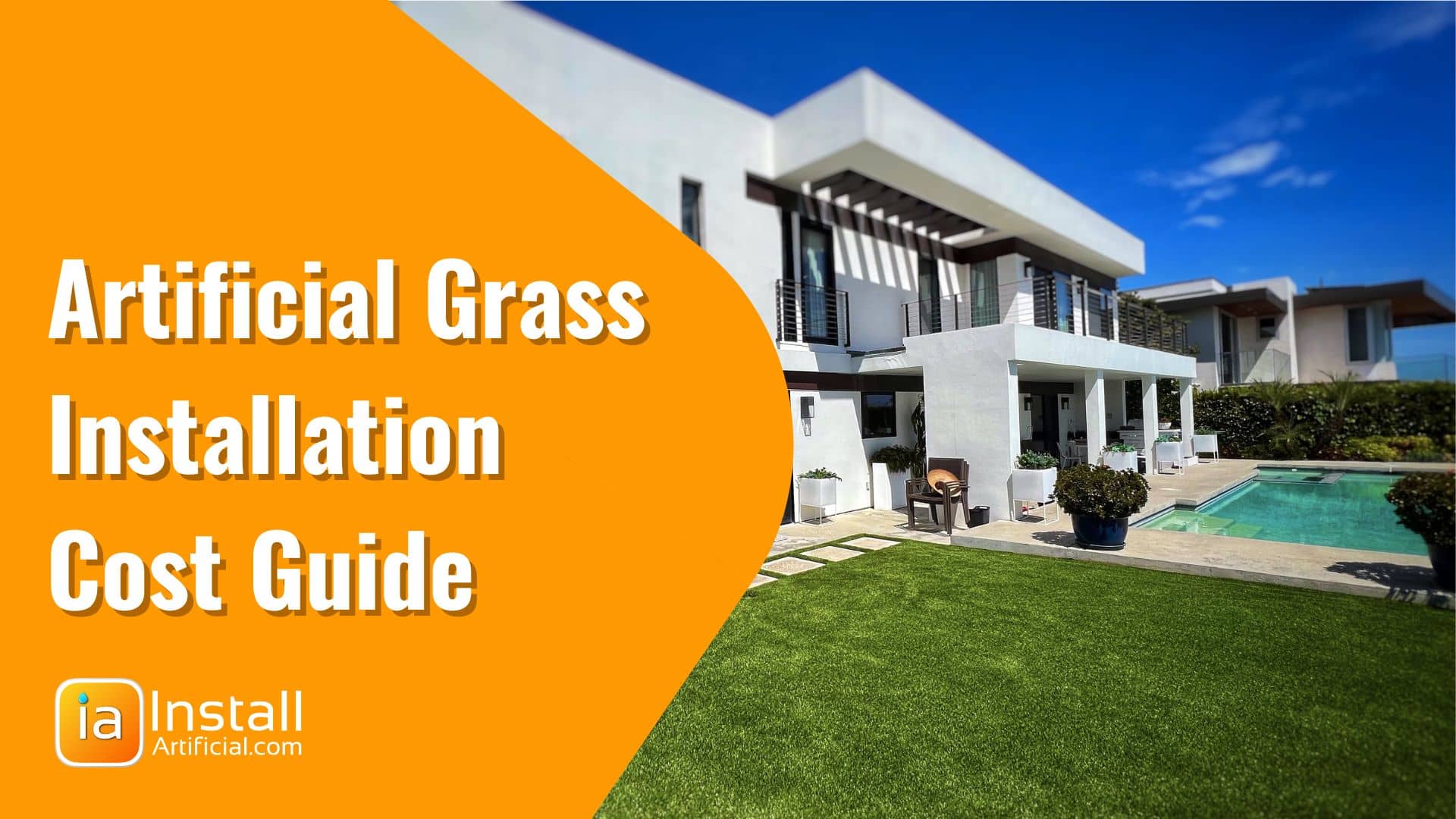
Updated on 05/12/2025
- Review the artificial grass installation cost breakdown and see how contractors cut corners to advertise lower prices.
- Navigate the artificial...
To learn how to prep and Install pet-friendly turf, check out our other article: How to Install Pet Turf - DIY!
Lay the turf roll in the sun for 30 minutes before unrolling. This will make the material more manageable. Unroll on a flat surface, ensuring all blades are facing in the same direction. If necessary, cut the turf to size to ensure it fits in your space. Measure multiple times before cutting!
If you are installing artificial grass near a patio or garden edge, you can simply remove the outer tuft along with the factory edge. However, if you are cutting to prepare for a seam, it is recommended to remove the outer three tufts and the factory edge. When laying two pieces of grass side-by-side, make sure the joining blades are standing vertically and not leaning towards each other.
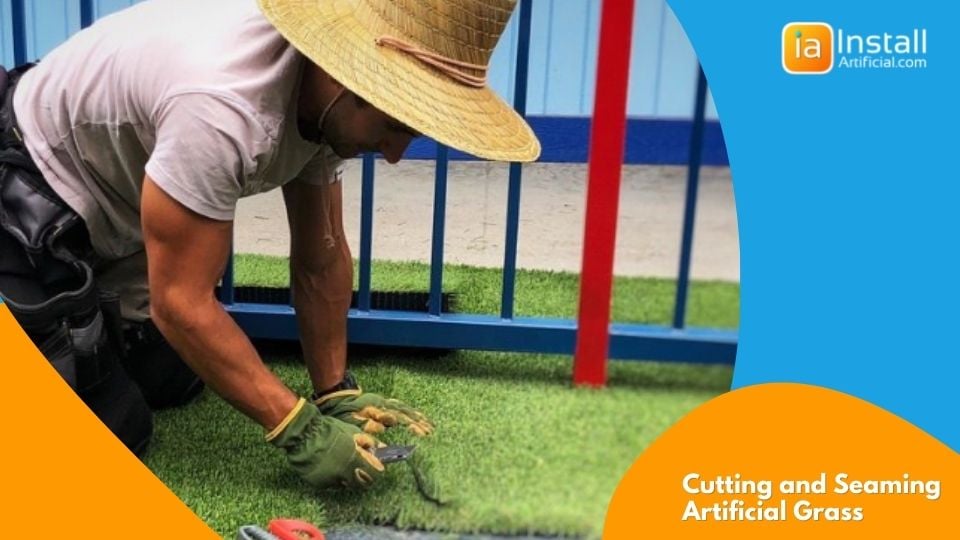
When trimming around a patio or garden edge, ensure that enough blade is sticking out of your knife to cut the backing before the blades. With the knife in one hand, grab the side of the grass being removed and pull it back to expose the backing. When cutting, the backing should be tight to the patio edge without touching, and the gap should be no bigger than 1/8 inch.
To cut up to a wall or fence, fold the turf back and press it tight to the corner. Place the blade against the backing where it lands closest to the wall, then lift the turf up and cut 6 inches at a time. Check the fit by laying it back down. Take your time to ensure the backing is not tight against the edges.
Relief cuts are necessary when cutting around corners, trees, or posts. Start from the furthest outward point and cut through from the backing out to the edge of the artificial grass. Remove any excess grass to make your next cut more manageable.
Similarly, when cutting against a wall or fence, fold the turf back and make small outward relief cuts at the point where the backing meets the object. This will allow you to cut from point to point, fitting the artificial grass to the exact curvature of the object. Take your time to avoid any gaps or fraying of the backing.
Once you have finished your cuts, the grass should lay loosely around any objects without touching them. This will create a beautiful and natural look, especially around stone, block trees, or any other perimeter on your installation site.
This step is only necessary if you have multiple pieces of artificial grass. Once the artificial grass is measured and cut to size, seam the pieces together using professional adhesive. For best results, use the zipper method to make the seams less visible.
When seaming in a straight line, the eye can spot small inconsistencies, and most often you'll see a line where the two pieces were seamed together. Instead, we break the line and cut the stitching before seaming to pull the pieces together the same way a zipper does. This method creates an illusion to the eye and will provide invisible seams.
A more popular method of seaming is creating an "S" shape on the edges of the pieces and seaming them together. When done correctly, this provides the same results as the zipper seam and hides the visibility of the seam. However, this is a much trickier method and it's easy to make mistakes. Once these mistakes are made, they're also extremely difficult to repair. For this reason, we'd recommend using the zipper method when seaming two pieces of artificial grass together.
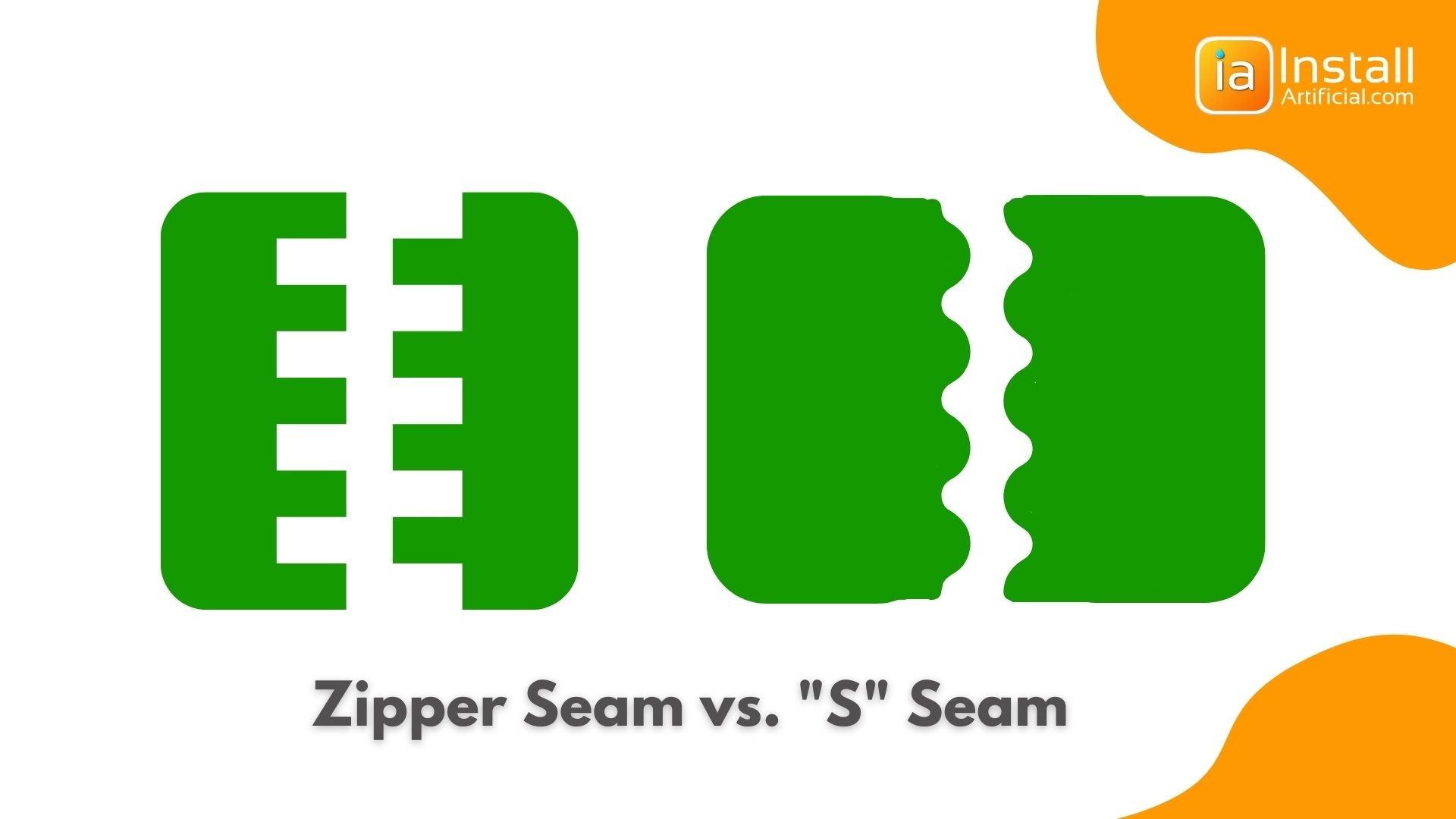
Stretch and nail down the turf along the perimeter every 2 in. Stretching the artificial grass on the sides is very important. It will help to prevent wrinkles and buckling over time. Make sure that the nails are hidden and deep. Use non-galvanized nails to ensure the nails won't come up over time. We also recommend nailing every 2 ft. throughout for added stability.
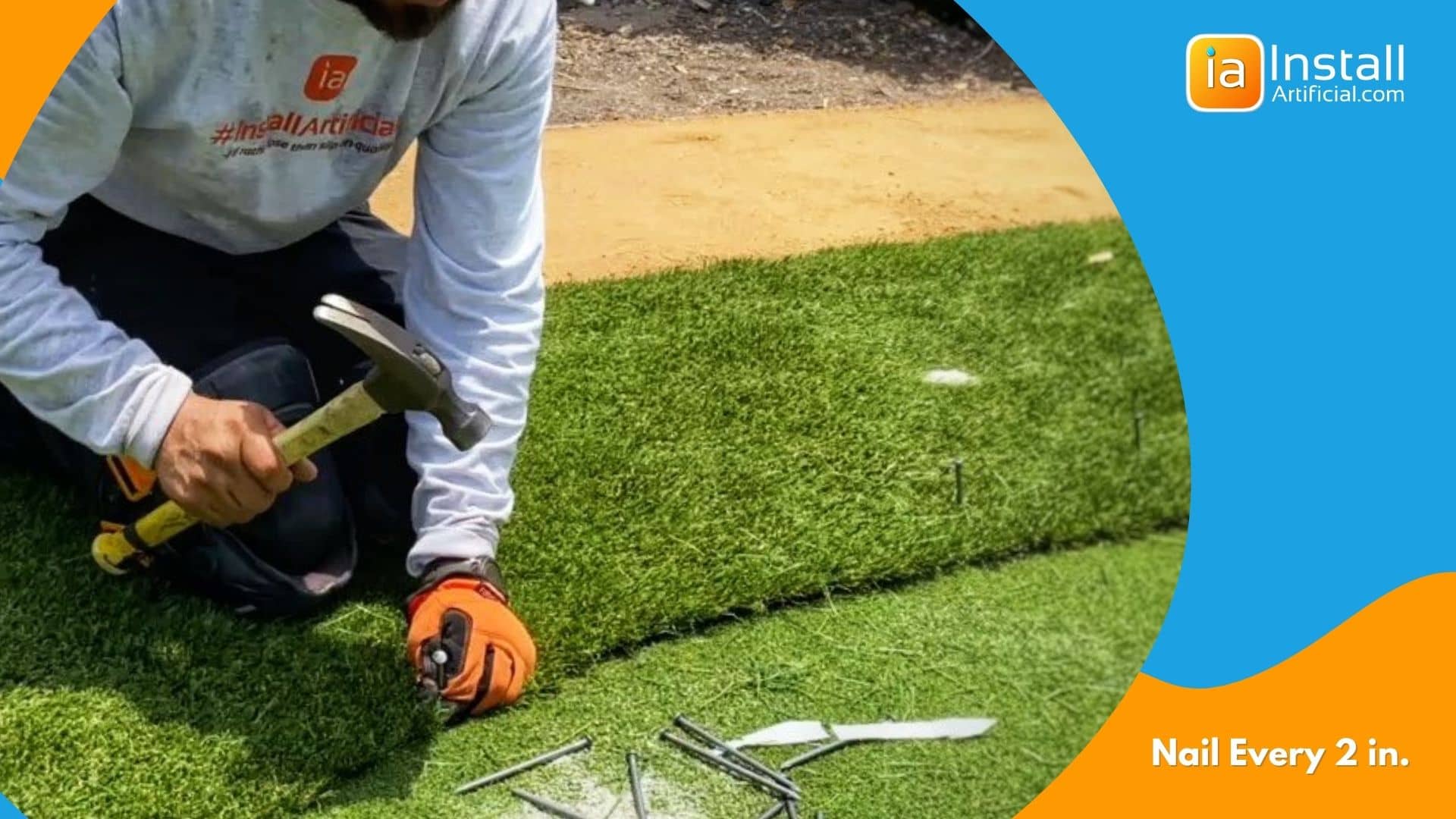
While many cut corners during this step, sand Infill in turf applications offers multiple benefits. This will help with blade recovery, protect the backing of your turf from harmful UV rays, and even prevent wrinkles! We'd recommend using an anti-bacterial sand infill to make the surface cooler and cleaner for pets and recreation. Lay approx. 1 lb. per sq. ft.
To infill the bulk of your artificial grass, start by placing a bag in your wheelbarrow and carefully slicing open the bottom with a utility knife. While a drop spreader can be used for this step, it's always a good idea to have a grain shovel on hand for filling in the edges and corners of your synthetic grass.
With a well-balanced load of infill on your shovel, hold it parallel to the ground and move in a smooth backwards motion, ensuring that you drop a consistent amount of infill with each pass. This technique may require some practice, but once you get the hang of it, you'll be able to effectively infill smaller areas using this method.
If you choose to use a shovel for infilling, make sure to maintain level scoops and ensure that the right side of your shovel is dropping the same amount of infill as the left side. Holding the shovel at an angle can result in unwanted bumps on the finished surface and may negatively impact the installation of the artificial turf.
Remember, there's more finesse involved than simply throwing sand onto the grass. Work in straight lines and ensure total coverage across the entire surface of the grass. With experience, you'll be able to distribute the infill from your shovel just as evenly as a drop spreader would.
Consistency is key when it comes to the infill layer. The smoother you spread it, the better the surface will feel underfoot once it's all brushed in. Apply the infill material in thin layers each time to achieve the best results.
Use a push brush to evenly distribute the sand across the surface, allowing the infill layer to seamlessly drop into the backing of your artificial grass. It's important to avoid using too much force when using a power broom on your turf, as this can cause more harm than good. Instead, apply firm downward pressure and gradually increase the throttle until the power broom effortlessly pushes you backwards. Walk slowly in reverse, maintaining steady pressure, to effectively work the infill deep into the artificial grass.
By using a low throttle, you'll prevent the infill from ending up in unwanted areas and achieve a smoother layer beneath the blades. Work methodically in rows, overlapping your passes to ensure that all of the infill is evenly distributed and the blades are standing upright. Continue with this technique until no visible infill remains on the surface of your artificial turf installation.
When working close to walls, angle the power broom so that the axle is away from the wall, allowing the bristles to brush down into the corner. It may take a bit of practice to find the perfect angle, but smooth out all perimeter edges and meticulously brush over your newly installed grass surface to ensure it is perfectly groomed and standing tall.
We recommend a power broom similar to this one on Amazon.
Perhaps one of the most sought out benefits of artificial lawns is reduced maintenance needs. Because you're removing soil and dirt from the surface, artificial grass can remain clean and pest-free for years! We'd recommend occasionally flushing the surface with a hose to remove dirt and debris. You can also use a stiff-bristled brush every so often on the surface to redistribute the turf infill and bring the blades upright if needed. To learn how to keep pet-friendly artificial turf clean, check out our favorite cleansers!
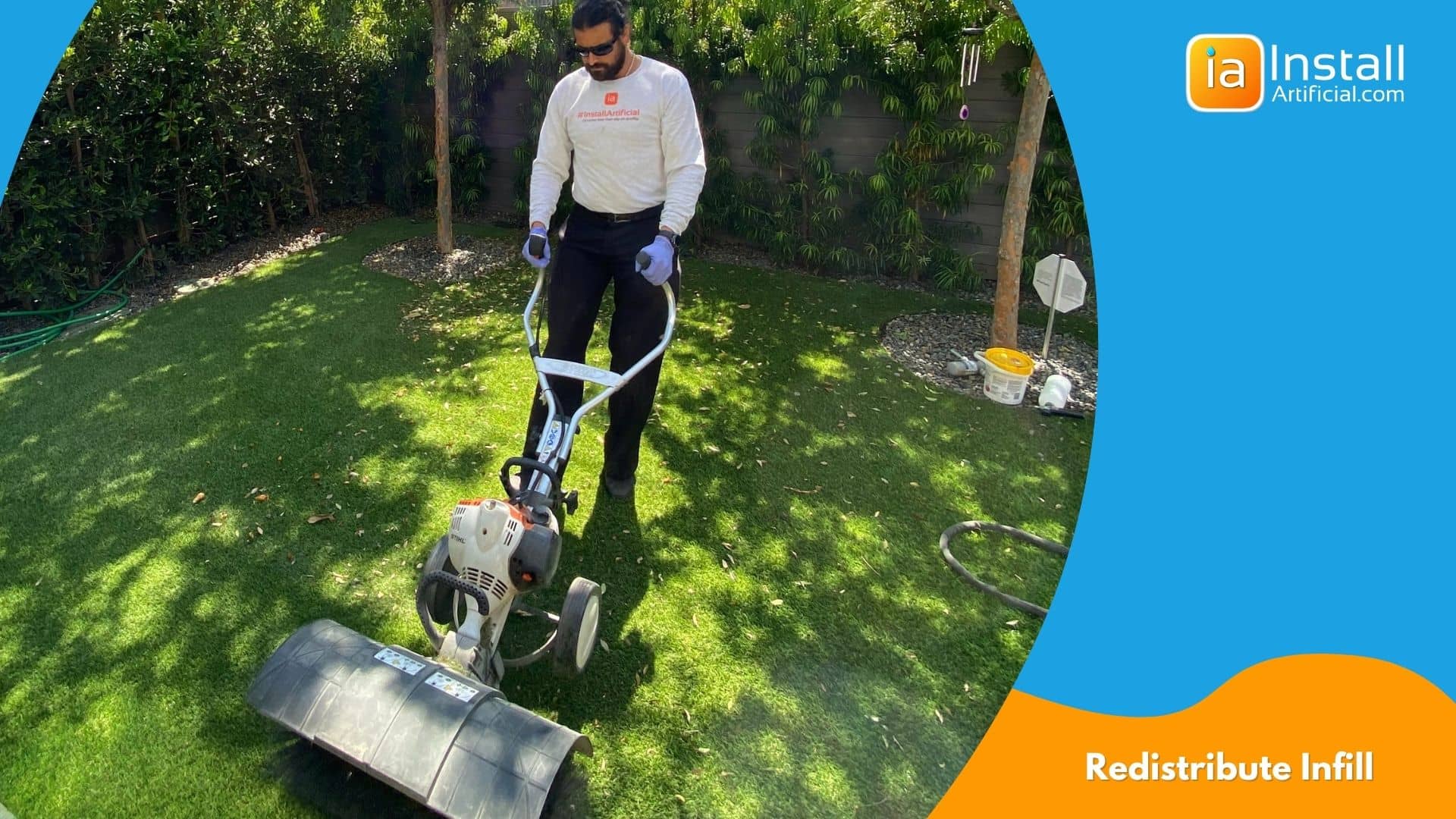
If you're ready to begin your DIY artificial grass project, let us support you the whole way! Check out our Online Turf Store to browse high-quality grasses from trusted suppliers, and get them at a discounted price. We'll assist you in purchasing the right fake turf for your needs, and ship it directly to you! Begin by requesting a deal below.
When it comes to installing artificial grass, it's important to do it the right way. One crucial aspect is to make sure you install it on dirt and not on top of existing grass or weeds. Take the time to prepare the dirt properly, ensuring it is smooth, flat, and free of any debris that could cause damage to your turf. For a step-by-step guide on how to install artificial grass on dirt, refer to our comprehensive artificial grass guide above.
When installing artificial grass on a concrete surface, it's crucial to pay extra attention to drainage. To ensure proper drainage, it's recommended to use a turf underlay beneath the artificial grass roll. This will allow water to drain out from underneath the turf, preventing issues such as mold and unpleasant odors, especially if you have pets using the grass. Additionally, using a turf underlay can make the artificial grass more comfortable to walk on, as concrete surfaces can be hard and cold. If you're installing on a concrete surface, be sure to follow our guide for installing turf on concrete, rooftop, deck & patios. For more information, click here.
It is strongly advised against laying artificial grass directly on top of your existing grass or lawn. This can lead to significant drainage issues and allow weeds to grow through the grass fibers, as there is no weed barrier in place. Additionally, the turf will have an uneven surface and its longevity will be reduced. If you choose to lay artificial grass in this manner, you will be wasting money and it will not be covered by any warranty.
When installing artificial grass between concrete slabs, it's best to use a stamp compactor when preparing the base to ensure it's solid even between the small gaps. 4" spaces are typically the most ideal for installing turf between pavers. It's also very important to make sure that all the blades are facing the same direction when you're laying and securing the strips. Want to learn more about installing fake grass between pavers? Check out our turf stripes installation guide now!
How to install artificial grass on a slope or a hill?
Installing artificial grass on a slope or hill requires a bit more effort and attention to detail compared to installing it on a flat surface. For large slopes, you'll need to install a membrane to keep the turf from slipping over time. You'll need to invest additional time and labor to ensure a smooth and even surface on your sloped terrain. Rest assured, though, that you can achieve artificial turf base preparation on sloped and flat landscapes to ensure a flawless installation.
When installing artificial grass on a balcony or deck, it is important to consider proper drainage. To ensure water can easily drain out from below the turf, it is recommended to use a turf underlay. This will help prevent issues such as mold and unpleasant odors, especially if you have pets using the grass. Additionally, a turf underlay can make the artificial grass more comfortable to walk on, as balcony surfaces can be hard on your feet and cold.
The cost of installing artificial grass can vary depending on various factors. In 2023, the average cost is estimated to be around $10-13 per square foot, including labor expenses. However, it's important to note that prices can range from as low as $8.50 per square foot to as high as $20 per square foot. If you choose to install the artificial grass yourself, you can expect to pay between $4.50 and $7 per square foot for materials alone, without factoring in labor costs.
To find out more about the cost of artificial turf installation, check out our artificial grass cost calculators for ballpark pricing in minutes!
Installing artificial grass can be a time-consuming process, especially if you're doing it yourself. Depending on the size of your yard, it may take anywhere from 1 to 3 days to complete the installation. However, if you want to save time and ensure a professional finish, it's worth considering hiring a professional landscaper. Not only will they have the expertise to get the job done quickly and efficiently, but they may also offer a warranty of up to 15 years on the installation. So, if you value your time and want the peace of mind that comes with a professional installation, it's definitely worth considering.
Yes, artificial grass goes by many names, but they all refer to the same thing. Whether you call it artificial turf, synthetic grass, fake grass, or astro turf, it's all a fantastic alternative to natural grass.
We highly recommend reaching out to your local artificial grass installer and seeing the product in person. This will give you a better understanding of its quality and suitability for your needs.
Before making a final decision, it's important to obtain multiple quotes that are specific to your property. This way, you can fully grasp the cost of astroturf per square foot and make an informed choice.